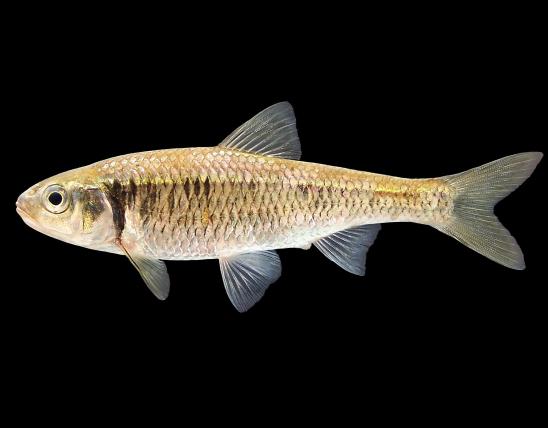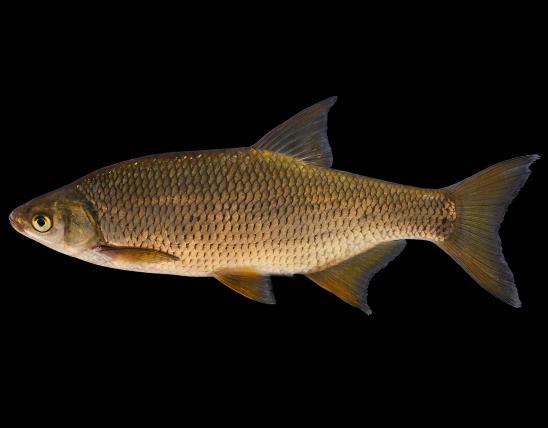
The mooneye, and the closely related goldeye, are both silvery, flat-sided fishes with large eyes and prominent teeth on the jaws, roof of the mouth, and tongue. A fleshy keel runs along the midline of the belly. The upperparts are greenish with silvery or golden reflections; the sides and belly are silvery white.
The mooneye can be separated from the goldeye by the following:
- The dorsal fin contains 11 or 12 principal rays, with the front of its base forward of the front of the anal fin base.
- The fleshy keel along the midline of the belly extends from the vent forward only as far as the bases of the pelvic fins.
- The eyes are relatively larger than in the goldeye, the diameter usually going 2.8 to 3.6 times into the head length.
- The iris of the eye is silvery, with only a trace of gold.
- The body is deeper, its depth going 3.1 to 3.4 times into the standard length.
Similar species: Mooneye and goldeneye both resemble herrings; both groups have a small triangular projection (called an axillary process) above the base of the pelvic fin, and both have smooth-edged (cycloid) scales over the body but not the head. However, unlike herrings, members of the mooneye family have prominent teeth, and the midline of the belly in mooneyes is keeled but lacks the row of spiny scutes found in herrings. Also, the dorsal fin in mooneyes is immediately above the base of the anal fin rather than far forward as in herrings, and a lateral line is present.
Adult length: commonly 9–11 inches; maximum length and weight for Missouri specimens is about 13 inches and ¾ pound.
The mooneye is less common than the goldeye over much of Missouri, but it occurs to the exclusion of the goldeye in large streams of the southeastern Ozarks.
Habitat and Conservation
Mooneye inhabit the larger pools of streams and the open waters of reservoirs. This species usually occurs in clearer, quieter water than the goldeye.
Food
Like the goldeye, the mooneye often feeds at or near the water’s surface, and its diet consists mostly of insects and small fishes. The unusually large eye probably is an adaptation for sight feeding under low-light conditions, at night or near dusk.
Status
The mooneye has never been common in Missouri collections and may be declining. This species has been declining in Lake Michigan and Lake Erie, and although they have apparently inhabited tributary streams historically, their distribution seems to be contracting to larger rivers.
Although the mooneye family now has its own separate order (Heidontiformes), the mooneye family used to be classified in the bony-tongue order (Osteoglossiformes), a group that includes the African knifefish, elephant-nose mormyrids, and arowanas you may have seen in tropical fish aquariums. You might notice that some references still list mooneyes in that order.
Life Cycle
The habits and life history of the mooneye are not well-known. Adult mooneyes in spawning condition have been taken in the Current River in March, indicating an early-spring spawning season. Like the goldeye, the mooneye’s eggs float, a characteristic rare in freshwater fish but more common in marine species. Lifespan is about 7 years (males) to 9 years (females).
Human Connections
The mooneye occurs over much of eastern North America. It is listed as threatened in Michigan, New York, and North Carolina. It has been extirpated from Maryland. Low water quality (especially silt, turbidity, and pollution) and habitat disruption (including dams, which block fishes’ migration routes) are some causes for its decline. Invasive species that outcompete mooneye for food and other resources are another cause for decline. The situation is not helped by the fact that many mooneye populations are disconnected to each other, so that if a population dwindles or disappears in a location, there are no nearby mooneyes to repopulate the area.
Ecosystem Connections
Mooneye and goldeye are visual predators that limit populations of insects and other small animals. They are preyed upon by larger fish, plus fish-eating birds, reptiles, and mammals.
There are only two living species in the mooneye family (Hiodontidae), the goldeye and the mooneye. They are restricted to North America, and both occur in Missouri. Three extinct species are also known. Mooneyes resemble shads or herrings but are not in the herring/shad family. The name comes from their large eyes, which have a metallic silvery or gold shine.


































